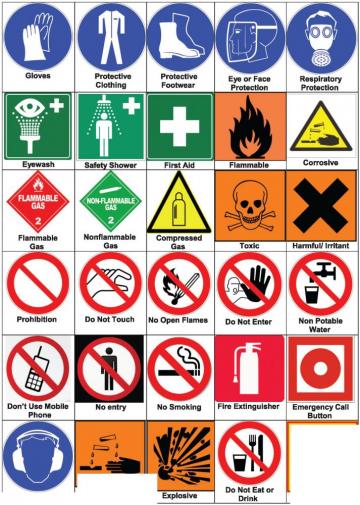
Laboratory safety
Everyone working in the laboratory should be cognizant of the potential hazards they face while working there. Fires with organic solvents, acid and base burns, toxic fumes and vapors are common hazards in almost any laboratory. Generally, laboratory safety is a matter of common sense, but there are several rules that must be followed. Commonly used laboratory safety signs have been shown in Figure.
The following material is provided as a brief summary and guide to laboratory safety. It does not replace assigned reading material, but gives an overview of some important points.
Laboratory neatness
Clean and neat work areas avoid risk of damage to clothing and books and injury from spilled chemicals. Neatness also reduces fire hazard.
Working with glassware
Remove frozen glass stoppers with proper equipment. Broken or chipped glassware should be discarded. Properly support glassware with ring-stands and clamps when heating and use cork rings with round-bottom flasks.
Working with glass tubing
Do not touch heated glass until it has time to cool. Hot glass looks just like cool glass. To remove stoppers from glass tubing or thermometers, grasp tubing close to stopper and push gently with twisting. Use water or glycerine for lubrication.
Laboratory dress
Aprons protect clothing from corrosive or staining chemicals. Gloves protect hands from corrosive chemicals. Handle hot objects with insulated gloves. Do not wear open-toe shoes that allow spilled chemicals or broken glass to come in contact with your feet.
Working with test tubes
Gently heat solids or liquids in a test tube near the liquid or solid surface; Be prepared to remove the tube from heat quickly to prevent eruption. Never point a test tube or reaction vessel at another person. For safety and neatness, place test tubes in a rack.
Chemicals in the eye
Rapid treatment is vital. Run large volumes of water over eyeball until medical help is available. Wash with large volumes of water for at least 15 minutes. Alkaline materials in the eye are extremely hazardous. Know the location of the emergency eyewash station.
Fire on clothing
Do not run or fan flames. Smother fire by wrapping victim in fire blanket or laboratory coat and use the shower or a carbon dioxide fire extinguisher.
Using a fire extinguisher
• Know its location
• Remove from mounting
• Pull pin
• Squeeze lever
• Discharge at base of flame
• Report use and recharge
• Use dry send to extinguish burning metals
Unauthorized experiments
Always work under instructor’s or lab technician’s supervision in the laboratory
Eye protection
Normal eye glasses are usually not adequate. Do not wear contact lenses in the laboratory. Eye protection is especially important when working with corrosive materials and vacuum and high pressure apparatus.
Acid/ alkali spills
For acid spills, use solid sodium bicarbonate followed by water. For alkali spills, wash with water followed by dilute acetic acid.
Handling flammable liquids
Flammable liquids should always be stored in an approved storage cabinet. Extinguish all flames in the area where flammable solvents are used, as vapours may travel to ignition source and flash back.
Types of fire extinguishers:
A – For ordinary combustibles; wood, paper and cloth
B – For flammable liquids, oil, grease and gasoline
C – For use on live electrical equipment.
Handling mercury spills are very hazardous. Droplets should be picked up by suction and a mercury spill kit used to complete clean up. Notify lab technician immediately when mercury spills occur.
Protection from toxic gases
Emergency air masks should be used. However, because our lab is not equipped with such masks, clear the area where gases are, and notify the lab technician.
Waste disposal
Hot glassware or reactive chemicals should be discarded in a non-metallic container separate from paper and other flammable waste. Test-tube quantities of hazardous liquid can be flushed down the sink with plenty of water. Contact lab technician for disposal of large quantities of hazardous materials.
Labelling chemicals
All chemicals should be clearly labelled. Do not use materials from unlabeled containers. Avoid contamination. Never return reagents to their container. Clearly label chemicals as you work.
Carrying chemicals
Carry long apparatus such as tubing or burettes, in an upright position close to the body. Grasp bottles firmly with both hands and hold them close to the body. Do not carry bottles by the neck. Use a bottle carrier when transporting chemicals any distance. Always arrange chemicals in chemical rack
Transferring liquids
Remember, acid or water do not pipette by mouth, use a bulb. Use gloves when pouring corrosive liquids. Use a funnel when filling a bottle or flask and prevent an air block by raising the funnel. Pour hazardous liquids over a sink.
Gas cylinders
Protect cylinder valve with cap. Fasten cylinders securely. Transport cylinders on a hand truck, don’t roll. Do not drop cylinders. Mark cylinders when empty.
